| Published in Attractions / Places of Interest |
Yosemite Park, California, United States
DANIEL ŞTEFĂNIŢĂ
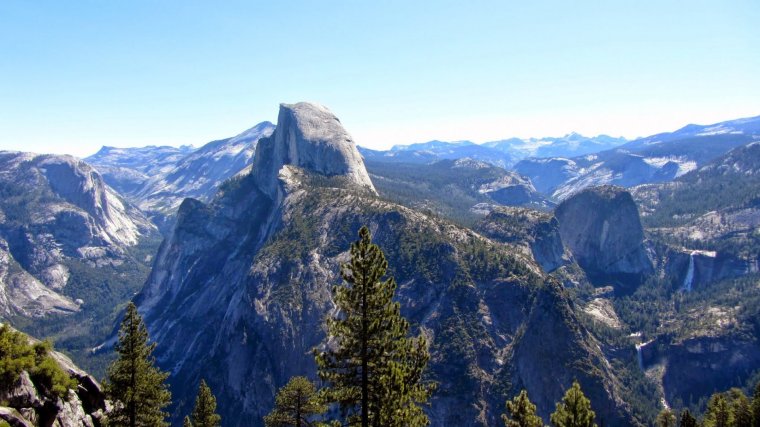
Half Dome (2695m at the top) seen from Glacier Point. Nevada Falls visible on the right.
Located in the splendor of the Sierra Nevada Mountains, Yosemite National Park was established in October 1890 by the American Congress.
Five distinct areas attract about four million visitors each year:
• Yosemite Valley,
• Wawona and Mariposa Grove of Giant Sequoias,
• Glacier Point,
• Tioga Road and Tuolumne Meadows, and
• Hetch Hetchy.
The park is open 24 hours a day. Access fees are payable at the entrance stations. The access permit costs $ 20 for a passenger car (regardless of the number of passengers) and is valid seven days (you can re-enter the park only upon showing the receipt). Visitors by bus, bicycle or other means of transport pay $ 10 per person. Individual permits of $ 40 are valid for one year. Keep the receipt because you must show it at the exit!
The park can be accessed through four main entrances:
• Northwest: Big Oak Flat Entrance via Highway 120
• East (summer and autumn): Tioga Pass via Highway 120
• West: Arch Rock Entrance via Highway 140
• South: Entrance via the highway 41
Getting to Yosemite
• By car. four hours from San Francisco or six hours from Los Angeles. All access roads are well maintained and most are open all year. The roads in the park are one-way, narrow and sometimes very winding. From November to April you must have chains for wheels available. The weather can change unexpectedly and the chains can become mandatory inside the park. To find out the state of the roads in the park you can call (209) 372 0200 where there are recorded messages.
• By plane and car.
— Fresno / Yosemite International Airport: three hours to South entrance
— San Francisco International Airport: three hours to North West entrance
— Los Angeles International Airport: three hours to South entrance
— Las Vegas Airport: eight to nine hours to East entrance.
• By bus. Yosemite Area Regional Transportation System (YARTS, yarts.com) offers rides from localities close to the park. The cost of a ticket is between $ 7 and $ 25 and includes the park entrance fee.
In the Yosemite Valley, visitors are encouraged to leave their cars at the specially designated parking lots and ride free shuttle buses that stop at 21 locations throughout the valley. During winter the shuttles only travel between the Yosemite Valley and the ski slopes in the Badger Pass area.
The weather
Yosemite generally enjoys hot and dry summers, mild spring and autumn, and not too cold winters with temperatures between -2 ° C and 12 ° C. No matter the season, be prepared for any weather. High elevation areas, such as Tuolumne Meadows, may be much colder than the Yosemite Valley or other lower elevation areas.
Rules to follow in the park
It is illegal to feed the wild animals. Also prohibited are hunting, gathering of archaeological objects such as arrowheads, the use of metal detectors to locate historical objects, entering with vehicles on meadows, camping outside designated areas, making fire in places other than the designated ones, use of firearms.
Do not leave food, debris or cosmetics in the car. Bears have a very fine smell and break cars to get food. If you stay in the tents, the food should be kept overnight in special containers made available by the park administration. Garbage is also disposed of in special metal containers. For fishing you need a permit issued by the State of California.
• Essential equipment for hiking:
• Topographic map, compass and GPS
• Whistle
• Lamps
• Sunglasses
• Foods with high energy content
• Sufficient amount of water
• Proper clothing; preferably use multiple thin layers
• Waterproof matches or lighter
• Insect spray
• pocket knife
• First aid kit
• Sturdy footwear
What to see in Yosemite Park
Yosemite Valley
Also called the "incomparable valley", the Yosemite valley, the most visited section of the park, has a length of 12km and a width of 1.6km in the widest part. The walls of the valleys are draped with waterfalls that usually have a maximum flow in spring and early summer, being fed by the melting snow.
• Bridalveil Fall. The Ahwahneechee Indians called this place Pohono, "the Spirit of the Blowing Wind." Wind gusts blow over the edge of the precipice and throw streams from one side of the waterfall to a spectacular fall. Although the Bridalveil waterfall looks small compared to the canyon walls, it actually falls 189 meters.
• Yosemite Falls. It is the tallest waterfall in North America with a height of 739 meters (in three sections), which qualifies Yosemite Falls as the sixth waterfall in the world, although with the recent discovery of Gocta Cataracta, Peru, it appears on some lists as the seventh.
• El Capitan. It is a 1095 meters high granite monolith from the base to the top. Mountain climbers from all over the world climb it from spring to autumn.
• Half Dome. It is the most remarkable monument in Yosemite, rising more than 1444 m, above the valley, up to an altitude of 2695m. The granite rock is 87 million years old. Raised by tectonic forces and eroded by glaciers and waters, Half Dome dominates the entire valley.
On March 28, 2009, 42,000 cubic meters were displaced at Ahwiyah Point. The landslide damaged a large area below the rock. No one was injured, but hundreds of trees were leveled, and a portion of the Mirror Lake trail was buried. The slip was recorded on seismographs as a 2.5 degree earthquake on the Richter scale.
In the 1870s, the Half Dome was described as "completely inaccessible." The peak was finally conquered by George Anderson in October 1875. Today, thousands of hikers reach the summit following a 13.7-km route from the base of the valley, and the last portion on cable.
• Tunnel View is one of the most photographed views in the world. It can be admired from the entrance to the Wawona tunnel (on route 41). It's a classic view that includes El Capitan, Half Dome, Sentinel Rock, Cathedral Rocks and Bridalveil Fall.
Glacier Point
It is a spectacular vantage point 980m above the Yosemite Valley, on the southern wall. From here you can see the entire valley, the rock formations and its waterfalls.
Other sights are: Wawona, Hetch Hetchy, Tioga Road, Tuolumne Meadows, the ski slopes of Badger Pass.
Activities in Yosemite Park
Besides the individual activities you can benefit from the ones offered by the park administration, including:
• Group excursions with park rangers that know the history, fauna and flora of the place.
• Photo tours offered by Ansel Adams Gallery.
• Art courses.
• Indian cultural program demonstrating the customs of American Indians in Yosemite. The demonstrations take place in the Indian village of Ahwahnee within the Yosemite Museum.
• The mountaineers' school offers mountaineering courses and excursions under the guidance of experts.
• Different excursions, such as: tour of the huge trees in Mariposa Grove, ascent to Glacier Point, full moonlight excursions, cross-country skiing to Glacier Point, night trips to see the stars.
A little history
Archaeologists have found evidence that people have lived sporadically in the Yosemite region for 8,000 years, after the last glaciation. Yosemite Valley has not been permanently inhabited for about 4,000 years.
The Miwok Indians believe that they were created here, and the anthropologists believe that their ancestors moved to the Yosemite area at the foot of the Sierra Nevada Mountains around 1000 BCE. They were called Ahwahnichi and the Ahwahni Valley, a Miwok word meaning "place like a gaping mouth." At one point, there may have been up to several hundred people living in the Yosemite Valley during the summer.
Yosemite comes from the name Yohhe'meti which in the language of the Miwok Indians means "those who kill". The Yosemite tribe consisted of renegades from several tribes.
The discovery of gold on January 24, 1848 marked the beginning of the end for the native population. In 1851, a battalion of troops, led by James Savage, entered Yosemite with the mission of ending the conflict. On this occasion the doctor of the expedition returned with stories about the beauty and grandeur of the place.
In 1903 President T.R. Roosevelt visited Yosemite with John Muir, a naturalist and nature conservation advocate.
From 42 tourists in 1855, their number has recently reached four million annually.
Yosemite Park in Pictures
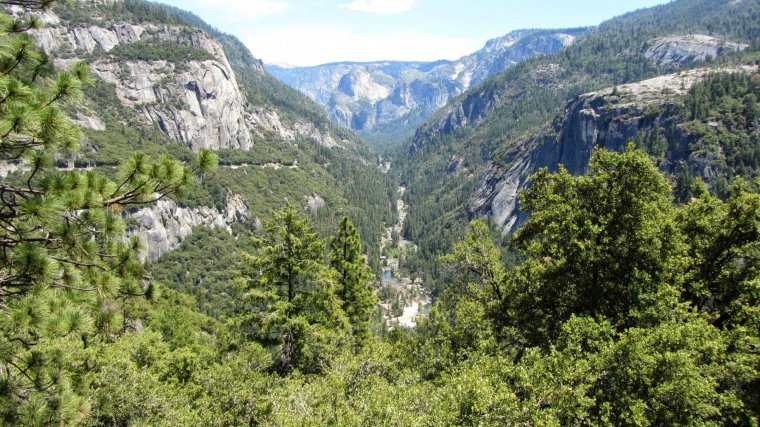
Yosemite Entrance

Tunnel View
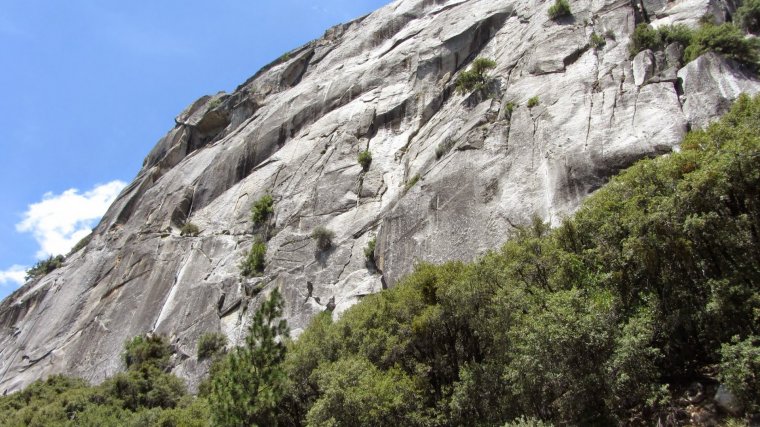
Climbers

El Capitan.
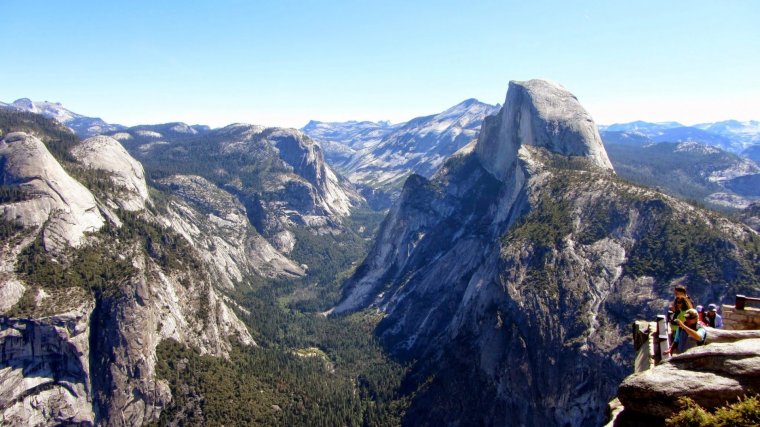
Half Dome and Tenaya Canyon.
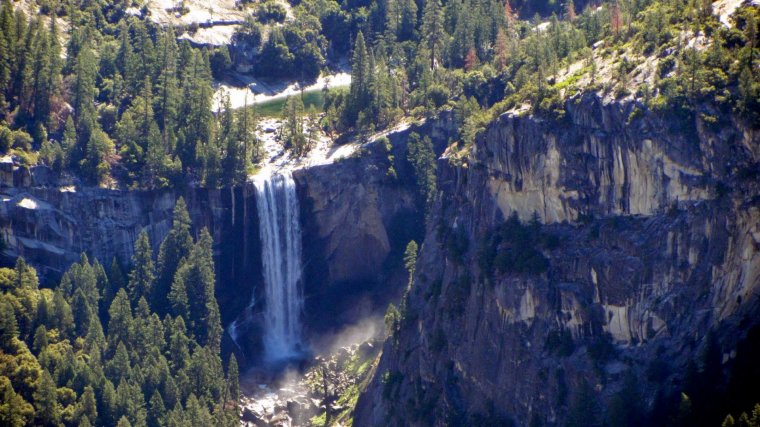
Vernal Fall

Four million tourists visit the park each year.
YOU MAY ALSO LIKE





 If you own or manage a travel-related business such as a hotel, a bed-and-breakfast, a restaurant, a pub or a cafeteria, you can create a web page for your business for free on Titi Tudorancea Travel Info. » |
